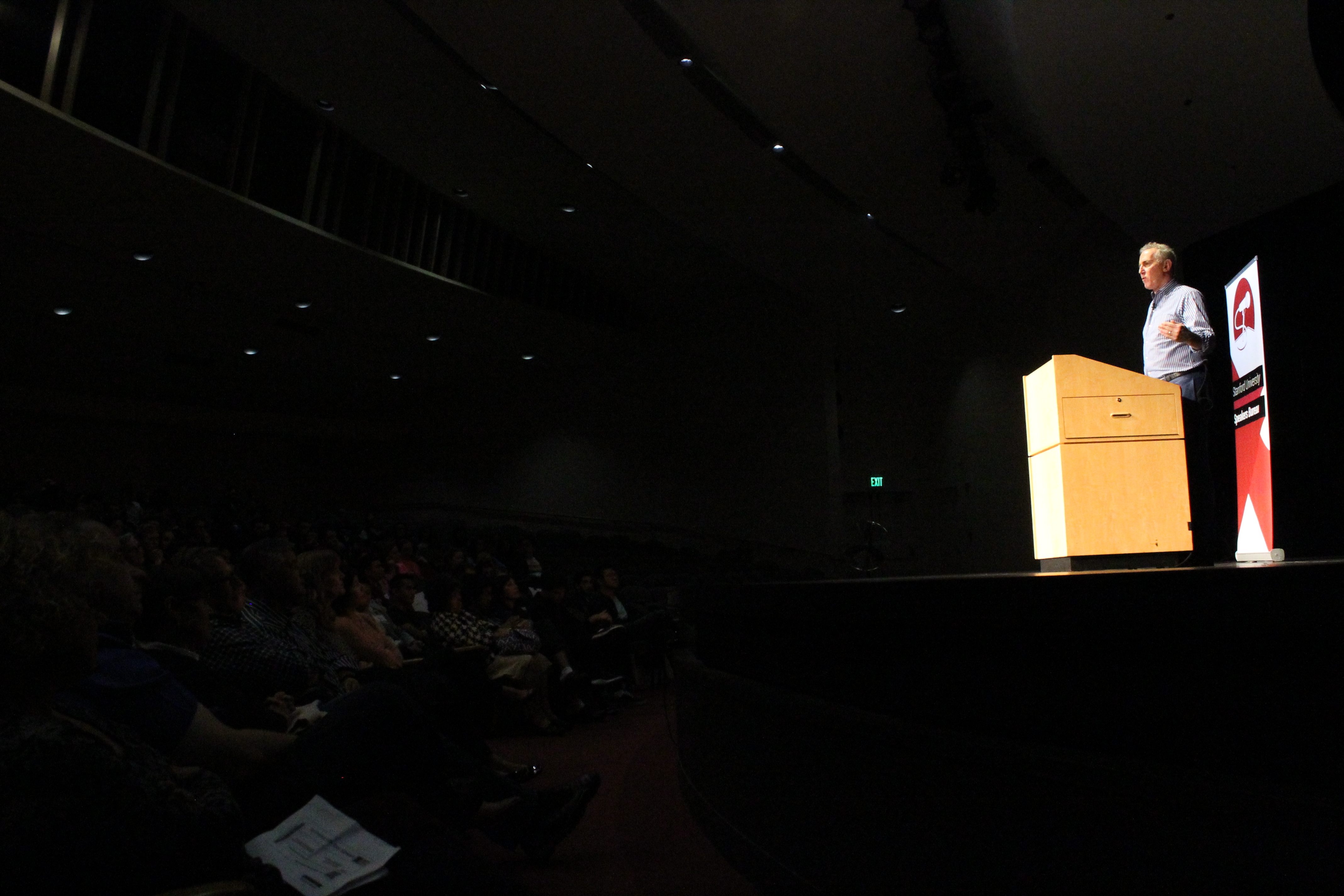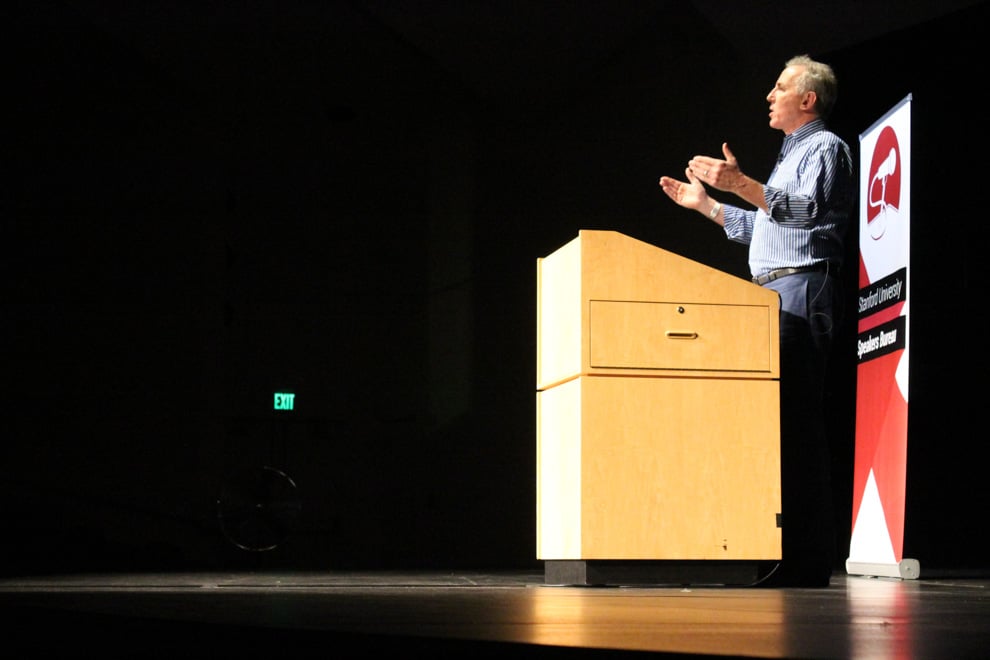
Tony Schwartz, the ghostwriter for “Trump: The Art of the Deal,” visited Stanford last week to discuss his experiences working with Republican presidential candidate Donald Trump and the lasting impact of those experiences on his life. “The Art of the Deal” is the Trump biography and business-advice book which has played a role in shaping public opinion of Trump since its publication in 1987.
The event took place on Thursday night and was organized by the Stanford Speakers Bureau and Stanford in Government. Schwartz discussed the features of Trump’s personality that he thought made him unfit to be president, as well as what he learned about himself and Trump during the process of writing the book.
Schwartz, who never imagined that the young, little-known real estate developer he had profiled 30 years ago would become a contender for president of the United States, was driven by the events of the 2016 election to publicly denounce the man whose reputation he had helped build.
From the moment he accepted the original offer to co-write “The Art of the Deal” with Trump, Schwartz said, he knew he was making a choice that ran against his moral compass. At the time, however, he justified the decision with the prospects of financial stability and ambitious desires for external validation.
“Writing Trump’s book could create security for my family and free me to do whatever I wanted to do next,” Schwartz remembered telling himself. “How bad could it be?”
Schwartz first encountered Trump while working as a journalist in New York. Trump had recently built the Trump Tower condominium, as well as a successful hotel at the top of Grand Central Station. In early 1985, Schwartz covered a story in which Trump attempted to coerce elderly tenants living under the protection of rent control from an apartment building in order to build a luxury condominium in the same location. According to the story, Trump hired a “tenant relocation” company that intentionally broke the elevators and refused to take care of repairs.
“The cover image of the article featured an illustration of Trump looking like a thug: red-faced, sweating, scowling. Trump loved it,” Schwartz said. “He especially loved the cover picture, and he called to tell me. For Trump, any publicity was good publicity … And in this case, he got a particular kick out of being portrayed as a tough guy. Almost immediately he had that magazine cover framed, and he put it up on the wall in his office right next to his desk. And I concluded that Trump was unlike any human being that I’d ever met.”
Trump brought up the idea of co-authoring a biography several months later. To obtain material for the book, Schwartz spent eight to 10 hours a day with Trump over a period of 18 months.
Schwartz soon discovered that he would have difficulty keeping his interviewee focused on a single topic for more than 20 minutes as a result of Trump’s short attention span. After one incident in which Trump stood up and announced that he could not stand to answer any more questions, Schwartz came up with the idea of collecting information through phone calls instead of through personal conversations. With Trump’s permission, Schwartz used an extension phone to listen in on Trump’s conversations with reporters, lawyers, bankers and brokers for several hours a day.
Often Schwartz would seek out these contacts for more in-depth conversations afterwards, and find that their information would directly contradict what Trump had been telling him.
“It was during these conversations that I realized I couldn’t take anything that Trump told me at face value … Trump has the ability to convince himself that whatever he’s saying at any given moment is true, or sort of true or at least ought to be true,” Schwartz said. “To this day, lying is second nature to him, just one more way to gain advantage.”
To continue to illustrate his impression of Trump, Schwartz shared details of Trump’s limited reading habits as well as his behavior towards his wife and children.
“His then-wife, Ivana, made it clear that she was not at all happy to have me there, which was understandable – her husband worked unceasingly during the week,” Schwartz said. “So each time Ivana walked by us with one or another of her three young children in tow, she glared icily at me and at him. I felt abashed, but [Trump] didn’t seem to give a damn.”
Despite his growing concerns at what he was seeing, Schwartz found a way to rework for the sake of the book what he called Trump’s “bullying and cynicism and one-dimensionality” into something “boyish and ingenuous and charming.”
The resulting product was hugely successful, spending 38 consecutive weeks on The New York Times bestseller list and most of that time in the number one spot.
To give his audience a feel for the nature of the book’s content, Schwartz read the opening paragraph of “The Art of the Deal” aloud, then proceeded to unpack its untruths sentence by sentence.
Throughout the presentation, Schwartz’s criticisms of Trump revolved around what he observed of the Trump’s personality and not his political positions.
“I didn’t make [the decision to expose Trump] ideologically because I don’t believe Trump has a deeply felt ideology beyond advancing his own interest. In the years that I knew him the best, he was some mix of a Democrat and a Libertarian,” Schwartz said.
Schwartz not only addressed his student audience as voters, but also as young adults who would have a lot of personal development ahead of them. He contrasted Trump’s “primitive instincts” for money, success and attention with the importance of self-awareness.
“I’m still that person who made a decision 30 years ago to write a book with a man named Donald Trump. That instinct and those needs haven’t disappeared,” Schwartz said. “But I’m also far more aware of those instincts and needs, and the result is that I have much more capacity to manage them, to make conscious choices about how I behave in the world. I don’t spend nearly as much energy as I once did – as Donald Trump still does every day – trying to prove and defend my own value. And in my case the happy consequence is that I have far more energy to create value.”
Schwartz has spent the past two decades running a company called the Energy Project, which works with organizations to help them better meet their employees’ needs for physical, emotional, mental and spiritual energy management.
He also made a commitment to accept no further royalties from sales of the book, and has since donated $85,000 to pro-immigration organizations.
Though Schwartz readily acknowledges the nationwide consequences of his inaccurate portrayal of Trump in “The Art of the Deal,” he remains unsure of whether it would have been better for him personally to not have written it at all because the experience has been so crucial to forming the person he is today.
“The truth is that the book I wrote, and my association with Trump, has haunted and dogged me for 30 years,” he said. “In many ways, the rest of my life has been a reaction to the experience of writing ‘The Art of the Deal.’”
Contact Emily Jusuf at ejusuf ‘at’ stanford.edu.
